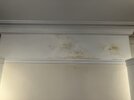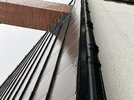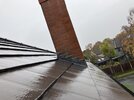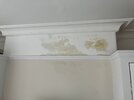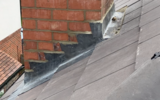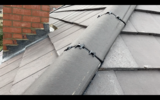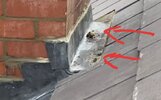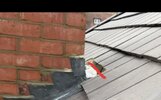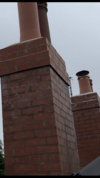- Joined
- 17 Feb 2023
- Messages
- 37
- Reaction score
- 0
- Country

Hi all
I started another thread which was about damp joists in our loft (here) and in one of the subsequent responses I mentioned how things have progressed and a damp chimney breast is now our key issue. I'm therefore creating a new thread to focus explicitly on the chimney. Apologies if you've read my problem twice as a result but I need to get to the bottom of the chimney issue as a priority and I was worried it wouldn't get seen in the other thread given it is just mentioned in a response.
I've just had my house re-roofed (new membrane, new battens , new thin edge sandtoft concrete tiles, and new dry ridge system).
Since then, we've had plenty of rain and we've had damp marks develop on the chimney breast in our bedroom - I've attached a photo of this (1490)
I've also been in the loft during heavy rain and the chimney breast has been wet to touch - video here
I have been struggling to engage with the roofer who did the original work, so I got an alternative roofer round. He said that the flashing has been done incorrectly on the chimneys for the roof tile that's been used.
I then took a photo of the flashing and sent it to the tile manufacturer, who agreed it hadn't been done right and said soakers needed adding due to the flatness of the roof tiles that have been used - I've attached photos of the flashing (see 1348 and 1349 below)
The roofer who did the original work came round yesterday, peeled back the flashing and essentially said "there is no evidence of water getting beneath the flashing, the roof is all fine. Moist air must be entering the loft from the house then condensing on the chimney and running down into the bedroom beneath. You need to insulate the floor of the loft better and less moist air will get up there".
I'm feeling at a bit of a loss now. I'm struggling to believe that it is condensation given we've been told by two other parties that the flashing has been done incorrectly. The size of the staining and amount of water also seems high for condensation. We also have a dry hip / ridge system, breathable membrane and vented eaves trays, so I would have thought there is enough ventilation up there to prevent significant amounts of condensation. In addition, I've only seen the chimney in the loft get wet during periods of heavy rain. I went up there yesterday morning (which was a very cold morning with no rain) and the chimney was dry to touch. If this was a condensation problem I would have expected it to be wet on a day like that as the bricks were very cold. So I'm really struggling to believe him.
So this is just a broad plea for any advice really - any suggested next steps?! What would you do? Do you think it could be condensation?
The only possible next steps I can think of are:
1) Ask the roofer to fit some vented roof tiles to increase airflow - if the problem still happens after this then surely it can't be condensation.
2) Insist the original roofer does the flashing as per the manufacturer's instructions
Thanks all
Andrew
I started another thread which was about damp joists in our loft (here) and in one of the subsequent responses I mentioned how things have progressed and a damp chimney breast is now our key issue. I'm therefore creating a new thread to focus explicitly on the chimney. Apologies if you've read my problem twice as a result but I need to get to the bottom of the chimney issue as a priority and I was worried it wouldn't get seen in the other thread given it is just mentioned in a response.
I've just had my house re-roofed (new membrane, new battens , new thin edge sandtoft concrete tiles, and new dry ridge system).
Since then, we've had plenty of rain and we've had damp marks develop on the chimney breast in our bedroom - I've attached a photo of this (1490)
I've also been in the loft during heavy rain and the chimney breast has been wet to touch - video here
I have been struggling to engage with the roofer who did the original work, so I got an alternative roofer round. He said that the flashing has been done incorrectly on the chimneys for the roof tile that's been used.
I then took a photo of the flashing and sent it to the tile manufacturer, who agreed it hadn't been done right and said soakers needed adding due to the flatness of the roof tiles that have been used - I've attached photos of the flashing (see 1348 and 1349 below)
The roofer who did the original work came round yesterday, peeled back the flashing and essentially said "there is no evidence of water getting beneath the flashing, the roof is all fine. Moist air must be entering the loft from the house then condensing on the chimney and running down into the bedroom beneath. You need to insulate the floor of the loft better and less moist air will get up there".
I'm feeling at a bit of a loss now. I'm struggling to believe that it is condensation given we've been told by two other parties that the flashing has been done incorrectly. The size of the staining and amount of water also seems high for condensation. We also have a dry hip / ridge system, breathable membrane and vented eaves trays, so I would have thought there is enough ventilation up there to prevent significant amounts of condensation. In addition, I've only seen the chimney in the loft get wet during periods of heavy rain. I went up there yesterday morning (which was a very cold morning with no rain) and the chimney was dry to touch. If this was a condensation problem I would have expected it to be wet on a day like that as the bricks were very cold. So I'm really struggling to believe him.
So this is just a broad plea for any advice really - any suggested next steps?! What would you do? Do you think it could be condensation?
The only possible next steps I can think of are:
1) Ask the roofer to fit some vented roof tiles to increase airflow - if the problem still happens after this then surely it can't be condensation.
2) Insist the original roofer does the flashing as per the manufacturer's instructions
Thanks all
Andrew

